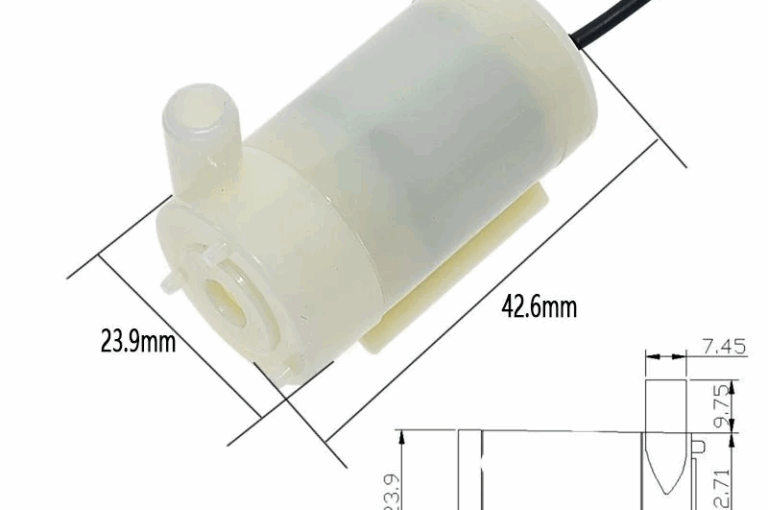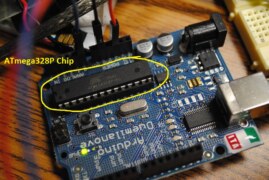Whether you’re building a DIY plant watering system or designing an automated aquarium setup, a submersible water pump is one of the most essential components you’ll need. It’s small, affordable, and incredibly powerful for its size.
But what exactly is a submersible water pump? How does it work? Which one should you use? And how does it compare to other types of pumps?
This guide covers everything you need to know to get started, with real-life use cases, comparisons, and best practices for beginners and electronics hobbyists.
What is a Submersible Water Pump?
A submersible water pump is a type of electric pump that operates while fully submerged in water. It’s commonly used in:
- DIY electronics projects
- Smart irrigation systems
- Hydroponics setups
- Aquariums and fountains
- Water cooling systems
These pumps are compact and run on low voltages (3V–12V), making them perfect for Arduino or Raspberry Pi-based automation projects.
How Does It Work?
A submersible pump works by using a DC motor connected to an impeller (fan) that rotates at high speed. When the pump is powered on, the spinning impeller creates suction, drawing water through an inlet and pushing it out through the outlet pipe or hose.
Since it’s submerged in water, it doesn’t require priming and is quieter than external pumps.
Basic Structure
- Waterproof plastic body
- DC motor inside
- Inlet and outlet ports
- Wires for power (usually red & black)
⚠️ Most small pumps don’t have reverse polarity protection — double-check before connecting!
Specifications of a Typical Mini Submersible Pump
| Parameter | Value |
|---|---|
| Operating Voltage | 3V–12V DC |
| Recommended Voltage | 5V or 6V for small projects |
| Max Flow Rate | ~80–120 L/H |
| Max Head (Lift) | ~40–110 cm |
| Power Consumption | ~1W–5W |
| Material | ABS Plastic |
| Noise Level | Low (submerged operation) |
| Waterproof Level | Fully sealed, submersible |
Applications of Submersible Pumps
- Smart irrigation systems using soil moisture sensors
- Aquariums and fish tanks for water circulation
- Plant watering projects with timers or relays
- Water feature projects like mini fountains
- Hydroponics nutrient cycling
- Water cooling for electronics
How to Use a Submersible Pump in DIY Projects
Required Components:
- Submersible pump (3–12V)
- Arduino or NodeMCU
- Relay module (to switch pump)
- Soil moisture sensor (optional)
- 12V power adapter or battery
- Tubing for water output
Circuit Connection Example (Using Relay):
| Component | Connects To |
|---|---|
| Pump Red Wire | NO (Relay) |
| Pump Black Wire | GND (Power Supply) |
| Relay COM | 12V Positive |
| Relay IN | Arduino digital pin |
| Power Supply | 12V DC Adapter |
You can also use a transistor (e.g., TIP120) for switching the pump directly if relay isn’t used.
Sample Arduino Code (Relay Control):
cppCopyEditint pumpPin = 8;
void setup() {
pinMode(pumpPin, OUTPUT);
}
void loop() {
digitalWrite(pumpPin, HIGH); // Turn pump ON
delay(5000); // Pump for 5 seconds
digitalWrite(pumpPin, LOW); // Turn pump OFF
delay(10000); // Wait 10 seconds
}
🧠 Tip: Use sensor input to activate the pump only when soil is dry.
Advantages of Submersible Water Pumps
- Quiet operation (water dampens sound)
- Compact and lightweight
- Doesn’t require external plumbing
- Easy to install in containers or tanks
- Safe for use in small spaces and projects
Limitations
- Not suitable for high-pressure requirements
- Must remain submerged while operating
- Some cheap models have lower durability
- Water leakage risk if seal fails
- Can overheat if run dry
Comparison: Submersible Pump vs Peristaltic Pump vs Diaphragm Pump
| Feature | Submersible Pump | Peristaltic Pump | Diaphragm Pump |
|---|---|---|---|
| Water Flow Rate | High (~100 L/H) | Low (~10–20 L/H) | Medium (~60–100 L/H) |
| Pressure | Low | High | Medium |
| Self-Priming | No | Yes | Yes |
| Use in Projects | Aquariums, irrigation | Precise dosing, medicine | Sprayers, misters |
| Cost | Very low (~$2–$4) | Medium (~$5–$10) | Medium-high (~$10–$15) |
| Lifespan | Medium | Long | Long |
| Maintenance | Low | Medium (tube replacement) | Medium |
Final Verdict:
- Submersible Pumps are perfect for general water movement
- Peristaltic Pumps are best for precise dosing
- Diaphragm Pumps are good for pressurized spray or misting
Maintenance Tips for Long Life
- Always keep the pump submerged while powered
- Clean debris from the inlet regularly
- Avoid running the pump dry (it causes overheating)
- Use filtered water for better lifespan
- Check wires and insulation for any leaks
Real-Life Project Idea: Smart Plant Watering System
Use a soil moisture sensor to detect when your plant is dry, and then trigger a submersible pump using a relay. Add a water tank and tubing — and voilà — you have a fully automatic garden!
Want a full tutorial on this project? Just ask — I’ll give you a full step-by-step.
❓ FAQs
Q. Can I use a submersible pump with Arduino?
Yes, but not directly. Use a relay or transistor to safely switch the pump using Arduino.
Q. What happens if the pump runs dry?
It may overheat and get damaged, especially low-cost ones. Always keep it submerged.
Q. Can I power it with a power bank?
Only if your power bank provides sufficient current (usually 1A or more). Most submersible pumps draw ~250–500mA.
Q. Is it waterproof?
Yes, submersible pumps are fully sealed for underwater use. But don’t expose the wires to water!
Q. Can I control water flow?
Some models have adjustable flow valves. Alternatively, you can use PWM control or reduce voltage.
Summary
A submersible water pump is a simple yet powerful component for countless electronics and automation projects. Whether you’re automating plant watering, building an aquarium filter, or making a DIY water fountain, this little module will do the job reliably.
Pros:
- Cheap
- Easy to use
- Quiet and efficient
Cons:
- Must stay submerged
- Not ideal for high-pressure needs
Choosing the Right Pump:
| Project Type | Recommended Pump |
|---|---|
| DIY Gardening | 5V/6V Submersible Pump |
| Precise Liquid Dosing | Peristaltic Pump |
| Spraying or Fogging | Diaphragm Pump |
| Aquarium or Hydroponics | Submersible Pump |
🚀 Final Words
If you’re just getting started with electronics or building your first automation project, a submersible water pump is a fantastic way to get your feet wet (pun intended 😄).
Keep it simple, test frequently, and always remember: electricity and water can be friends — only if used safely!


